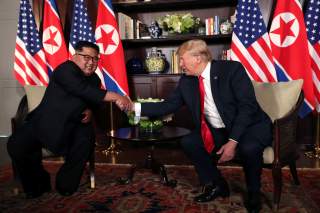The Hanoi Summit – We Asked Olivia Enos What Happens Next in U.S.-North Korea Relations
"It’s time to institute a diplomatic strategy that recognizes the linkages between promoting human rights and making progress on denuclearization."
Editor’s Note: Looking for more opinions on where we go after the Hanoi summit? Check out all 80 expert takes on where U.S-North Korea relations go next here.
The second summit did not go the direction many expected. The lack of progress made in Hanoi—and Singapore, for that matter—present an opportunity to reset U.S. policy toward North Korea.
If the U.S. learned anything from the latest summit, it’s that North Korea desperately seeks sanctions removal. In a press conference after the inconclusive end to the summit, the North Koreans said that they sought sanctions removal for humanitarian reasons. Frankly speaking, care for the North Korean people is the furthest thing from Kim Jong-un’s mind, particularly considering that he imprisons between 80,000 to 120,000 individuals in modern-day gulags.
Instead, these statements reveal that maximum pressure is the one aspect of the Trump administration’s policy toward North Korea that worked. Sanctions pressure is not only partially responsible for bringing North Korea to the negotiating table, but it is also responsible for putting the squeeze on the regime’s viability and development of its weapons programs.
Early indicators suggest that the administration is considering a return to maximum pressure in the wake of failed diplomatic efforts. This is the right move, as was Washington’s rejection of Pyongyang’s disingenuous request for essentially complete sanctions relief in exchange for incomplete denuclearization in Hanoi.
As the administration recalibrates U.S. policy toward North Korea, it should take a close look at current U.S. sanctions policy—most importantly, the priorities reflected in U.S. sanctions law—and re-orient U.S. diplomatic efforts accordingly. Ahead of the Hanoi summit, I released a Heritage Foundation paper laying out a roadmap for the administration to leverage current sanctions law to advance human rights and security objectives with North Korea.
Current sanctions law obligates America not only to make progress on denuclearization but also on human rights. That’s why it makes little sense that diplomatic efforts focus solely on making forward progress on denuclearization. It’s time to institute a diplomatic strategy that recognizes the linkages between promoting human rights and making progress on denuclearization.
The reality is that not all sanctions can be lifted if North Korea only denuclearizes, so if it’s sanctions relief Pyongyang seeks, then it must make improvements on a variety of fronts.
Moving forward, if the United States seeks a truly maximum pressure policy, it should target Chinese banks that America knows is responsible for laundering money for Pyongyang and make more active use of human rights-oriented sanctions authorities that enable the United States to target the Kim regime on human rights grounds. Finally, if America is willing to call for eventual complete, verifiable, irreversible dismantlement (CVID) of North Korea’s nuclear program, it should be equally bold in calling for the CVID of North Korea’s political prison camps. A more comprehensive policy toward North Korea that aligns diplomatic efforts with U.S. priorities as outlined in current U.S. sanctions law is liable to be far more successful than the current strategy.
Olivia Enos is a Policy Analyst in The Heritage Foundation’s Asian Studies Center.
Image: Reuters

